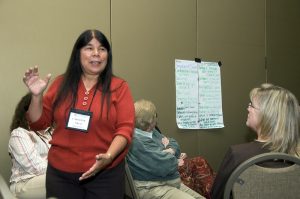2 American Indian Territories

Did you notice a small proportion of American Indians in your investigation of Census data? In this section, you will learn about the tribal communities tied to your geography. You will also learn about what happened to many tribal communities in the 1800s and beyond.
Use the map link below to explore tribal lands, languages, and treaties tied to where you live. Once you’ve opened the link, type in the name of the city or town where you live in the search box. You will then find the map displays different tribal groups and languages where you live. You can eliminate the colors to see the current names of towns and roads. You will find that there are links to the tribal groups and treaty agreement histories that pop-up on the left side of the page. Please use these links to learn more about the history of where you live. You can learn about tribal community history, for example, by clicking on the links associated with the location on the map. The links will appear in a box on the left side of the web page. If you noticed a low proportion of American Indians in your zip code, use the native land map to find out what happened to people living in tribal groups on the land where you currently live. You will find culture and history sections of websites for tribal communities that are linked on this map.
Follow these instructions:
Go to: https://native-land.ca/
- Click on “Go to map”
- Type the name of your town in the search box
- Click on “Open street map labels”
- Click off “Colors”
- Scroll to find the location where you live
- Click on “Colors” (notice overlap and large areas indicating that nomadic people moved into different areas at different times of year)
- You will find relevant information appear in a box on the left of the page. Investigate the links showing the territory and reservation connected to the people you are learning about.
- Follow the tribal community links and find the tribal history and culture link.
What did you learn? Does this history explain the racial demographics of “American Indian” in your census tract?
To learn more about broken treaties in Oregon, view the documentary below: https://watch.opb.org/video/oregon-experience-broken-treaties-oregon-experience/

